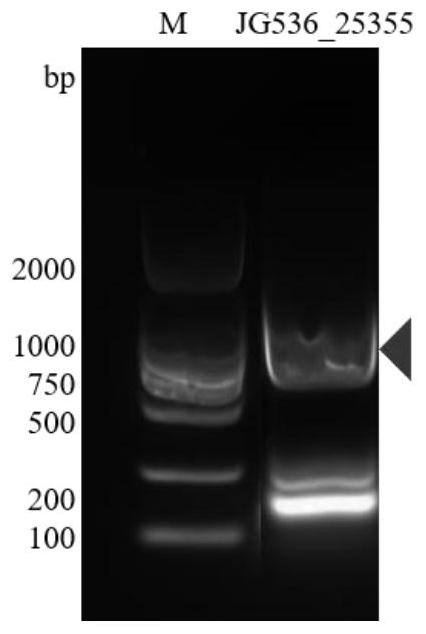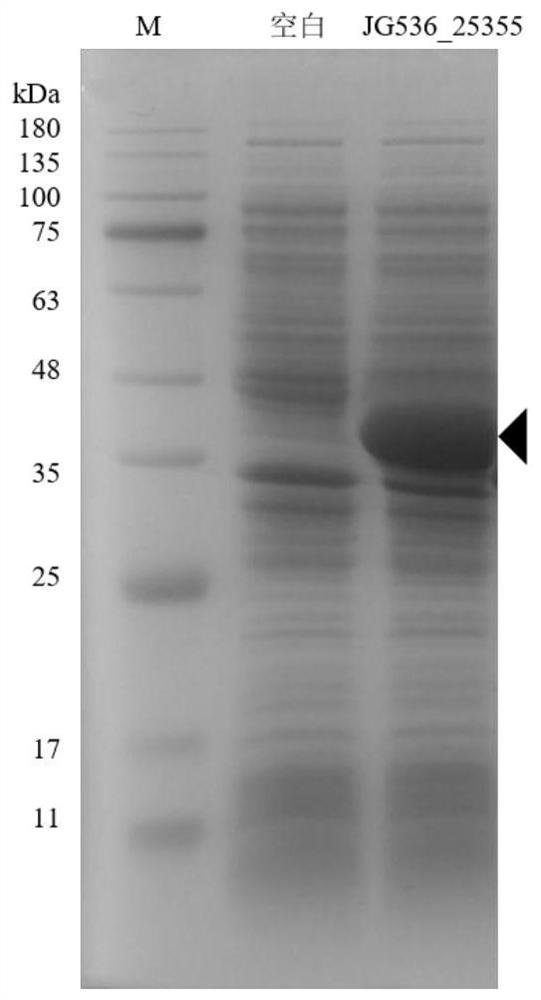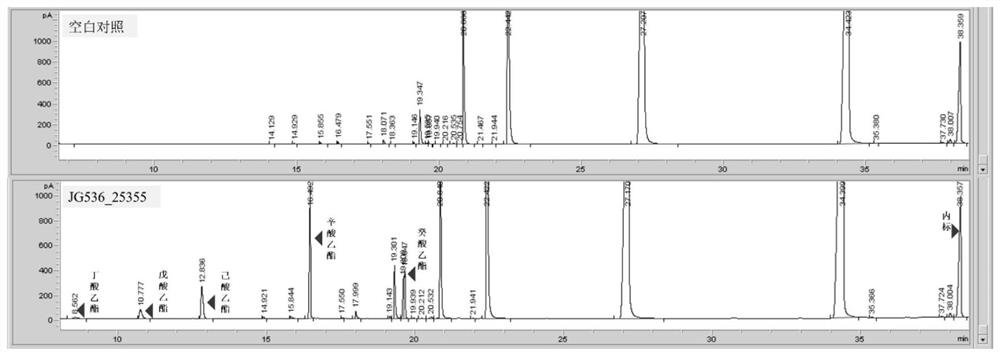Burkholderia bidirectional ester synthase JG53625355, coding gene and application of Burkholderia bidirectional ester synthase JG53625355
A technology of Kholderia and Holderia, applied in the field of genetic engineering, can solve the problems of lack of research, unfavorable ester synthesis reaction, etc.
- Summary
- Abstract
- Description
- Claims
- Application Information
AI Technical Summary
Problems solved by technology
Method used
Image
Examples
Embodiment 1
[0041] Cloning of the gene encoding the ester synthase JG536_25355 of embodiment 1
[0042] 1.1 Cultivation of Burkholderia and extraction of genomic DNA
[0043] Burkholderia BJQ0010 (CGMCC 24186) was inoculated into the fermentation medium, cultured on a shaker at 200±10r / min, 30±1°C for 24-72h. The fermentation medium is composed of soluble starch 10g / L, peptone 10g / L, NH 4 HSO 4 1g / L, K 2 HPO 4 1g / L, MgSO 4 0.8g / L, olive oil 10mL / L, natural pH, sterilized at 121°C for 15min.
[0044] The cultured bidirectional Burkholderia was collected by centrifugation, and the total DNA was extracted by BIOMIGA bacterial DNA extraction kit (BIOMIGA [Biomiga Shanghai Technical Service Center], model GD2411). The specific operation steps are carried out according to the conventional operation method of the kit.
[0045] 1.2 Specific amplification of the gene encoding ester synthase JG536_25355
[0046] The gene encoding Burkholderia-derived ester synthase JG536_25355 was amplifi...
Embodiment 2
[0054] Example 2 Construction of an E. coli engineering strain expressing ester synthase JG536_25355
[0055] 2.1 Linearization of pET-28a(+) vector
[0056] Linearization of the circular pET-28a(+) vector was performed using PCR. Primers were designed as follows:
[0057] Forward primer (SEQ ID NO.5): 5'-ATCGCACTCGAGCACCACC-3'
[0058] Reverse primer (SEQ ID NO.6): 5'-CATGGTATATCTCTCTTCTTA-3'
[0059] The PCR reaction system and amplification cycles are shown in Table 3 and Table 4, respectively.
[0060] Table 3 Example 2 PCR linearization reaction system of circular pET-28a(+)
[0061] Reagent Volume (μL) dd H 2 o
72.0 dNTP Mixture (2.5mM each) 8.0 10×Ex Taq Buffer 10.0 Forward primer (10μM) 4.0 Reverse primer (10μM) 4.0 pET-28a(+) vector 1.0 Q5 DNA Polymerase (5U / μl) 1.0 Total 100.0
[0062] Table 4 embodiment 2PCR amplification cycle
[0063]
[0064] 2.2 Plasmid construction
[0065] pass II...
Embodiment 3
[0071] Example 3 Ester synthase JG536_25355 crude enzyme liquid aqueous phase system catalyzes the synthesis of ethyl butyrate, ethyl valerate, ethyl hexanoate, ethyl caprylate and ethyl caprate
[0072] 3.1 Preparation of ester synthase JG536_25355
[0073] Use colony PCR to verify the cultured colonies, select the correct transformants and transfer them to SOC liquid test tubes (containing a final concentration of kanamycin sulfate 40-80mg / L), shaker at 150-250r / min, shake at 37±2°C for 10-15h, Then inoculate the Erlenmeyer flask containing the SOC medium with 1-5% (v / v), shake the shaker at 150-250r / min, shake and cultivate at 37±2°C until the cell density is 0.6-0.8 (OD 600nm ), and then add IPTG at a concentration of 0.01-0.10mM as an inducer, shake at 150-250r / min, and culture with shaking at 25±2°C for 15-24h. The cultured cells were collected by centrifugation at 8000 rpm for 5 min, washed with 0.05M Tris-HCl buffer solution (pH 7.5) twice and suspended. The suspende...
PUM
 Login to View More
Login to View More Abstract
Description
Claims
Application Information
 Login to View More
Login to View More - R&D
- Intellectual Property
- Life Sciences
- Materials
- Tech Scout
- Unparalleled Data Quality
- Higher Quality Content
- 60% Fewer Hallucinations
Browse by: Latest US Patents, China's latest patents, Technical Efficacy Thesaurus, Application Domain, Technology Topic, Popular Technical Reports.
© 2025 PatSnap. All rights reserved.Legal|Privacy policy|Modern Slavery Act Transparency Statement|Sitemap|About US| Contact US: help@patsnap.com



